Abstract
In 1977 several patients were seen with soft-tissue sarcomas and previous exposure to phenoxy acids. This clinical observation resulted in a cases-referent (case-control) study being undertaken which showed that exposure to phenoxy acids or chlorophenols, which are chemically related, gave a roughly six-fold increase in the risk for this type of tumour. A further case-referent study of soft-tissue sarcomas has now been performed to confirm these earlier findings and also to obtain further information on the effects of different phenoxy acids. This new investigation gave an increase of the same magnitude in the risk for soft-tissue sarcomas after exposure to phenoxy acids or chlorophenols, but this risk related also to exposure to phenoxy acids free from impurities, such as polychlorinated dibenzodioxins and dibenzofurans.
Full text
PDF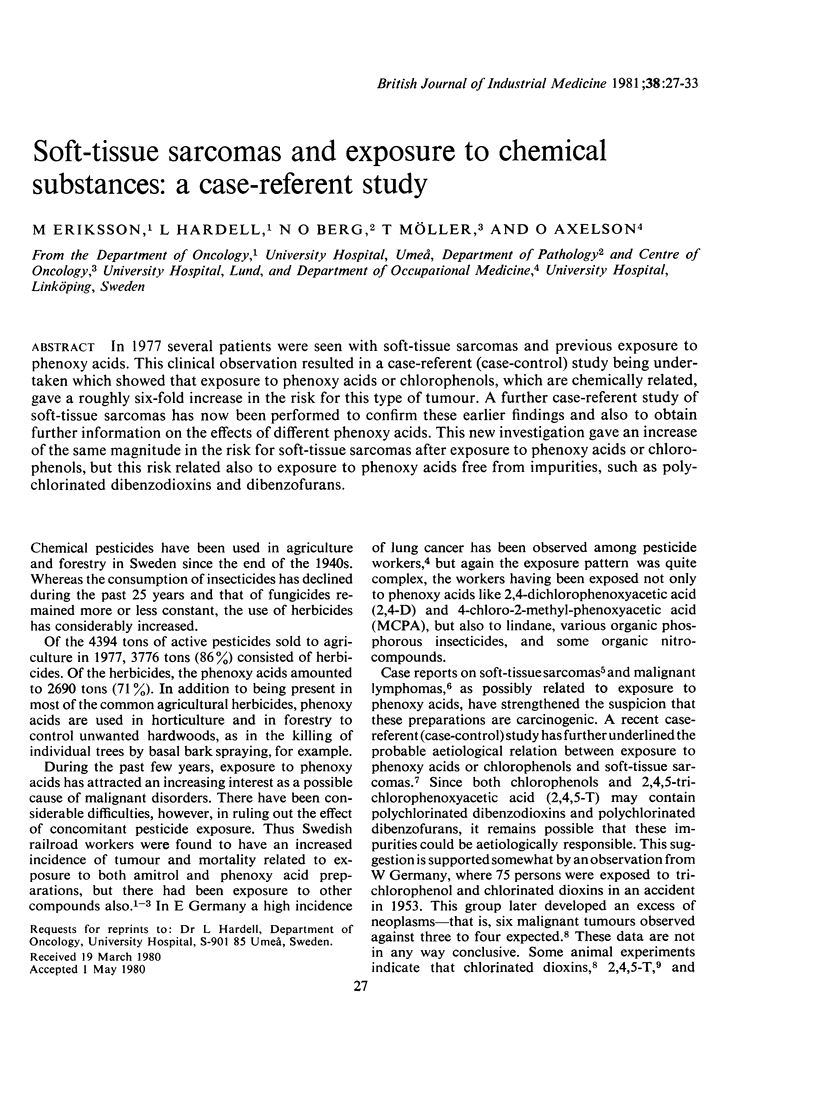
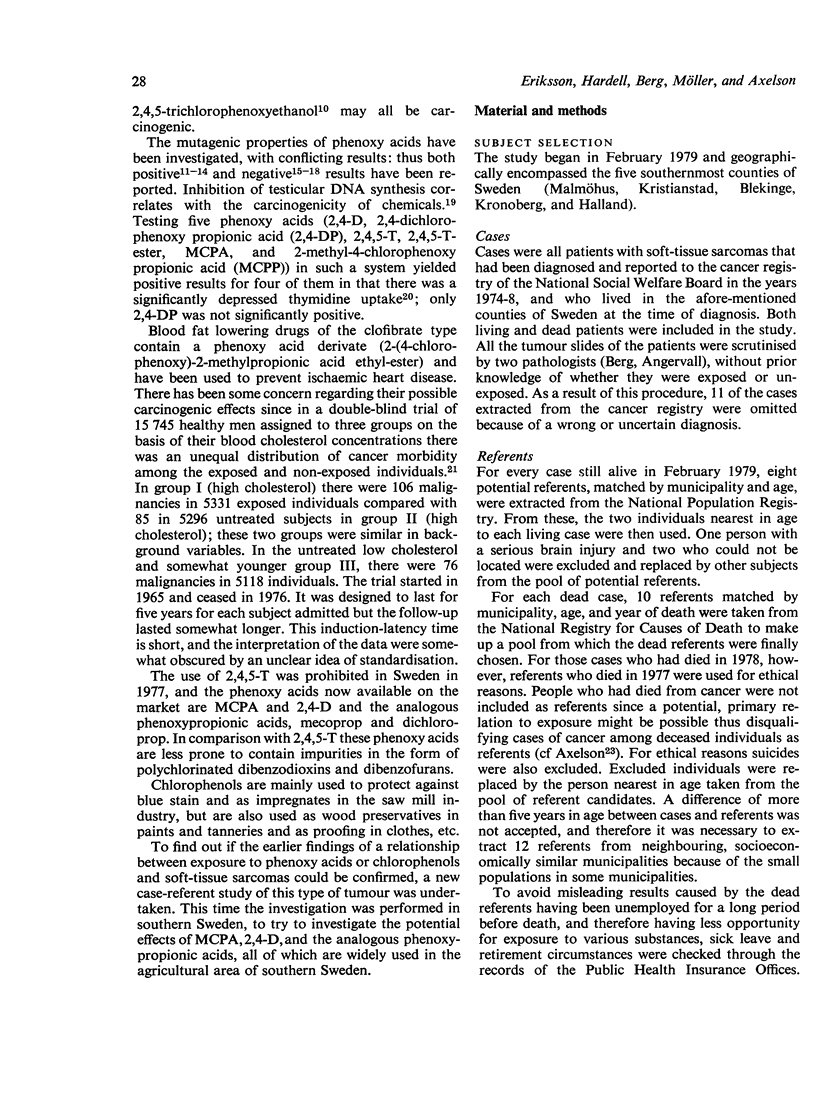
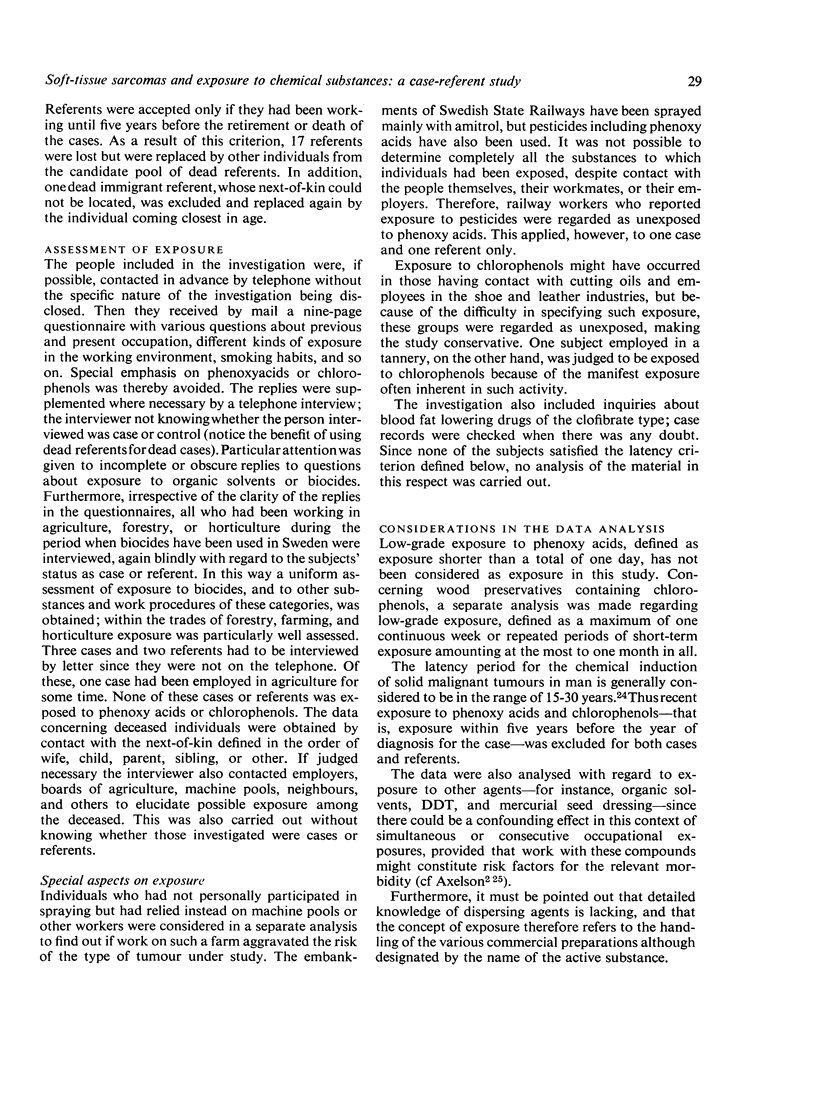
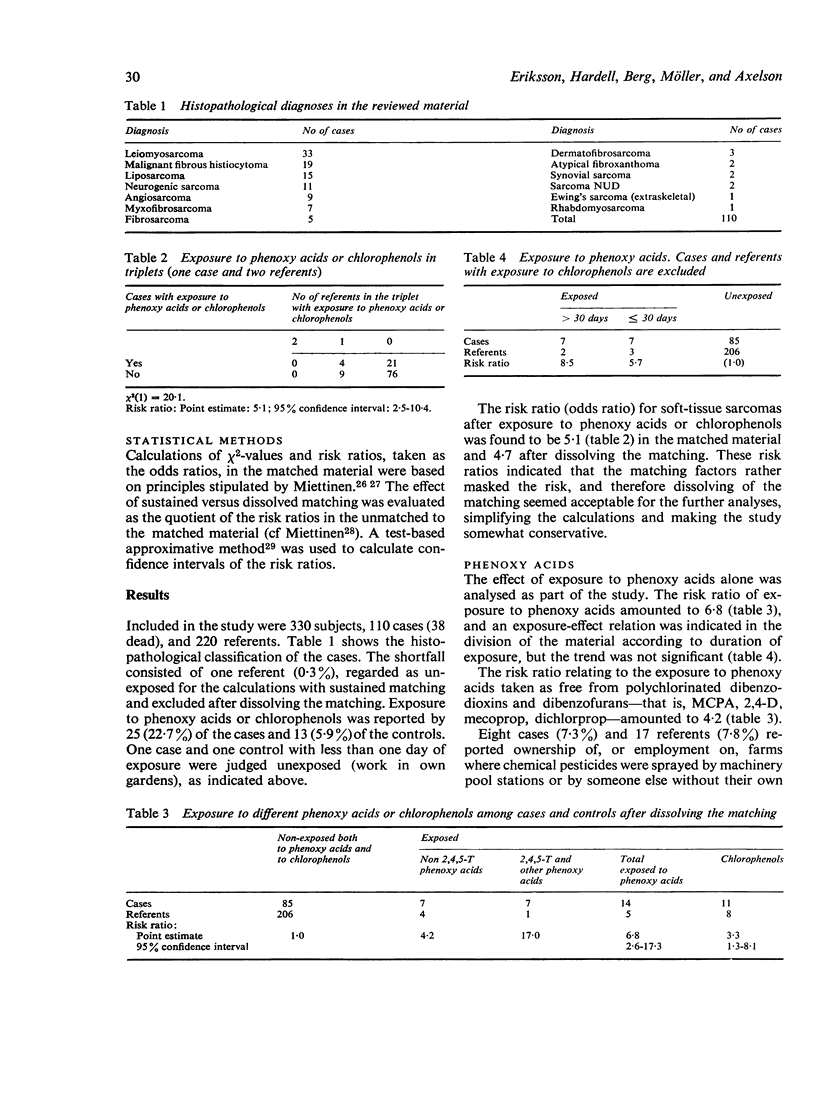
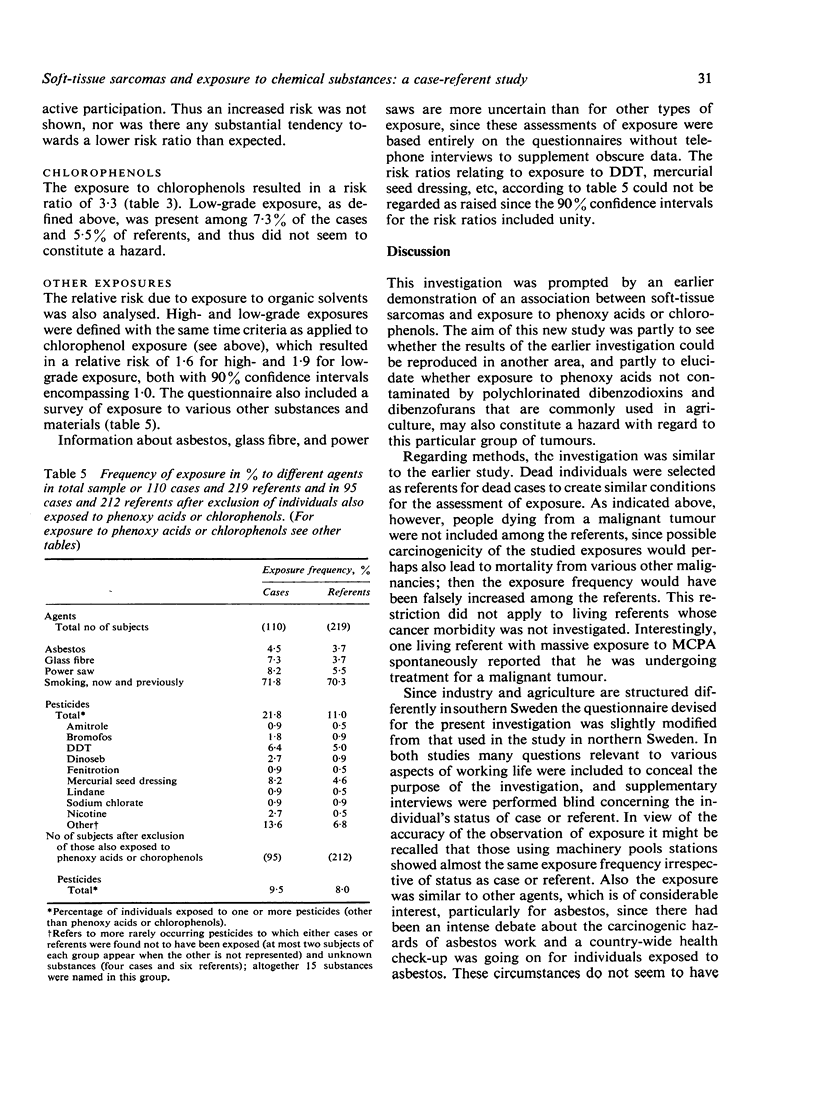

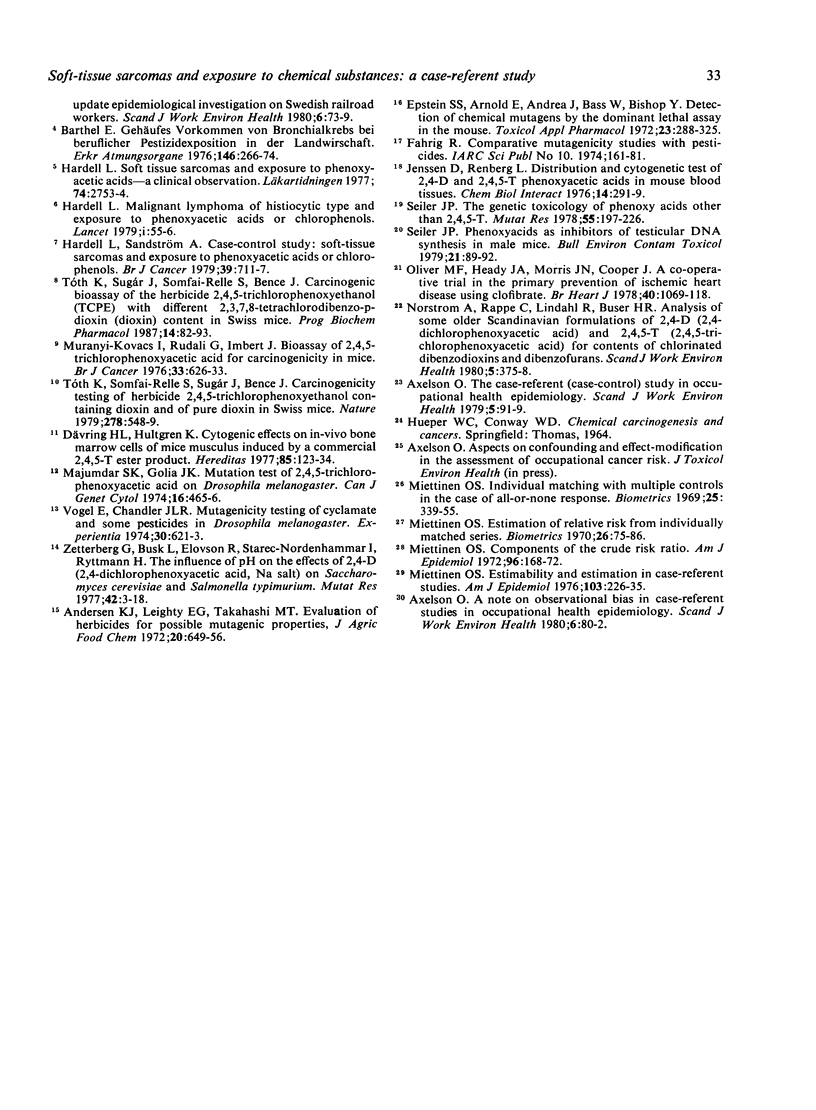
Selected References
These references are in PubMed. This may not be the complete list of references from this article.
- A co-operative trial in the primary prevention of ischaemic heart disease using clofibrate. Report from the Committee of Principal Investigators. Br Heart J. 1978 Oct;40(10):1069–1118. doi: 10.1136/hrt.40.10.1069. [DOI] [PMC free article] [PubMed] [Google Scholar]
- Anderson K. J., Leighty E. G., Takahashi M. T. Evaluation of herbicides for possible mutagenic properties. J Agric Food Chem. 1972 May-Jun;20(3):649–656. doi: 10.1021/jf60181a046. [DOI] [PubMed] [Google Scholar]
- Aspects on confounding in occupational health epidemiology. Scand J Work Environ Health. 1978 Mar;4(1):98–102. doi: 10.5271/sjweh.2720. [DOI] [PubMed] [Google Scholar]
- Axelson O. A note on observational bias in case-referent studies in occupational health epidemiology. Scand J Work Environ Health. 1980 Mar;6(1):80–82. doi: 10.5271/sjweh.2630. [DOI] [PubMed] [Google Scholar]
- Axelson O., Sundell L. Herbicide exposure, mortality and tumor incidence. An epidemiological investigation on Swedish railroad workers. Work Environ Health. 1974;11(1):21–28. [PubMed] [Google Scholar]
- Axelson O. The case-referent (case-control) study in occupational health epidemiology. Scand J Work Environ Health. 1979 Jun;5(2):91–99. doi: 10.5271/sjweh.2654. [DOI] [PubMed] [Google Scholar]
- Barthel E. Gehäuftes Vorkommen von Bronchialkrebs bei beruflicher Pestizidexposition in der Landwirtschaft. Z Erkr Atmungsorgane. 1976 Sep;146(3):266–274. [PubMed] [Google Scholar]
- Epstein S. S., Arnold E., Andrea J., Bass W., Bishop Y. Detection of chemical mutagens by the dominant lethal assay in the mouse. Toxicol Appl Pharmacol. 1972 Oct;23(2):288–325. doi: 10.1016/0041-008x(72)90192-5. [DOI] [PubMed] [Google Scholar]
- Hardell L. Malignant lymphoma of histiocytic type and exposure to phenoxyacetic acids or chlorophenols. Lancet. 1979 Jan 6;1(8106):55–56. doi: 10.1016/s0140-6736(79)90509-9. [DOI] [PubMed] [Google Scholar]
- Hardell L., Sandström A. Case-control study: soft-tissue sarcomas and exposure to phenoxyacetic acids or chlorophenols. Br J Cancer. 1979 Jun;39(6):711–717. doi: 10.1038/bjc.1979.125. [DOI] [PMC free article] [PubMed] [Google Scholar]
- Majumdar S. K., Golia J. K. Mutation test of 2,4,5-trichlorophenoxyacetic acid on Drosophila melanogaster. Can J Genet Cytol. 1974 Jun;16(2):465–466. doi: 10.1139/g74-049. [DOI] [PubMed] [Google Scholar]
- Miettinen O. S. Components of the crude risk ratio. Am J Epidemiol. 1972 Aug;96(2):168–172. doi: 10.1093/oxfordjournals.aje.a121443. [DOI] [PubMed] [Google Scholar]
- Miettinen O. S. Estimation of relative risk from individually matched series. Biometrics. 1970 Mar;26(1):75–86. [PubMed] [Google Scholar]
- Miettinen O. S. Individual matching with multiple controls in the case of all-or-none responses. Biometrics. 1969 Jun;25(2):339–355. [PubMed] [Google Scholar]
- Miettinen O. Estimability and estimation in case-referent studies. Am J Epidemiol. 1976 Feb;103(2):226–235. doi: 10.1093/oxfordjournals.aje.a112220. [DOI] [PubMed] [Google Scholar]
- Muranyi-Kovacs I., Rudali G., Imbert J. Bioassay of 2, 4, 5-trichlorophenoxyacetic acid for carcinogenicity in mice. Br J Cancer. 1976 Jun;33(6):626–633. doi: 10.1038/bjc.1976.100. [DOI] [PMC free article] [PubMed] [Google Scholar]
- Norström A., Rappe C., Lindahl R., Buser H. R. Analysis of some older Scandinavian formulations of 2,4-dichlorophenoxy acetic acid and 2,4,5-trichlorophenoxy acetic acid for contents of chlorinated dibenzo-p-dioxins and dibenzofurans. Scand J Work Environ Health. 1979 Dec;5(4):375–378. doi: 10.5271/sjweh.2643. [DOI] [PubMed] [Google Scholar]
- Seiler J. P. Phenoxyacids as inhibitors of testicular DNA synthesis in male mice. Bull Environ Contam Toxicol. 1979 Jan;21(1-2):89–92. doi: 10.1007/BF01685392. [DOI] [PubMed] [Google Scholar]
- Seiler J. P. The genetic toxicology of phenoxy acids other than 2,4,5-T. Mutat Res. 1978;55(3-4):197–226. doi: 10.1016/0165-1110(78)90004-0. [DOI] [PubMed] [Google Scholar]
- Tóth K., Somfai-Relle S., Sugár J., Bence J. Carcinogenicity testing of herbicide 2,4,5-trichlorophenoxyethanol containing dioxin and of pure dioxin in Swiss mice. Nature. 1979 Apr 5;278(5704):548–549. doi: 10.1038/278548a0. [DOI] [PubMed] [Google Scholar]
- Vogel E., Chandler J. L. Mutagenicity testing of cyclamate and some pesticides in Drosophila melanogaster. Experientia. 1974 Jun 15;30(6):621–623. doi: 10.1007/BF01921506. [DOI] [PubMed] [Google Scholar]
- Zetterberg G., Busk L., Elovson R., Starec-Nordenhammar I., Ryttman H. The influence of pH on the effects of 2,4-D (2,4-dichlorophenoxyacetic acid, Na salt) on Saccharomyces cerevisiae and Salmonella typhimurium. Mutat Res. 1977 Jan;42(1):3–17. doi: 10.1016/s0027-5107(77)80003-1. [DOI] [PubMed] [Google Scholar]


